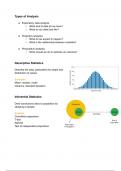Summary
Summary Bioinformatica - sequence
- Module
- Institution
Good summary can also be used before the exam. With the elaborations and explanations of jupyternotebooks, questions and codes. The lessons have also been written out and useful links for additional information added Good summary which is usable for the exam. With explanations of the jupyternote...
[Show more]









